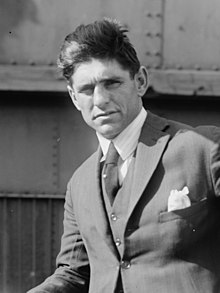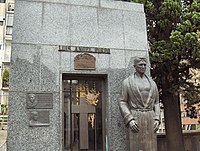Luis Ángel Firpo
| Luis Ángel Firpo | |
|---|---|
 Firpo in 1919 | |
| Statistics | |
| Nickname(s) | El Toro Salvaje de las Pampas |
| Height | 6 ft 2.5 in (1.89 m) |
| Born | 11 October 1894 Junín, Buenos Aires, Argentina |
| Died | August 7, 1960 (aged 65) |
| Stance | Orthodox |
Luis Ángel Firpo (October 11, 1894 – August 7, 1960) was an Argentine boxer. Born in Junín, Argentina, he was nicknamed The Wild Bull of the Pampas.
Boxing career[]
In 1917, Firpo began his professional boxing career by beating by a decision in six in Buenos Aires. Originally declared a no decision, the bout's result was later changed to a win for Firpo.[citation needed]
For his second bout, he traveled, in January 1918, to Montevideo, Uruguay, where he suffered his first defeat, a first round knockout at the hands of . He put a string of six wins in a row after that, and so on November 1, 1919, he found himself challenging in Santiago, for the South American Heavyweight title. He lost on that occasion by a decision in 15 rounds, but then came back with a win over by a knockout in round six.

On April 20, 1920, he and Mills had a rematch and Firpo won the title with a first-round knockout. After one more win, he and Mills faced each other in a rubber match, and the result was the same as that of their second bout: Firpo the winner by a knockout in the first. In 1921, the quality of Firpo's challengers improved, when he defeated fringe contender Gunboat Smith twice, the first by decision in 12 and the second by knockout, also in 12.
In 1922, he continued his rise in the Heavyweight rankings by winning all four of his fights by a knockout.
Firpo began 1923 by knocking out former title challenger Bill Brennan in the 12th round. He followed that with seven more wins in a row, including wins over Jack McAuliffe and former world champion Jess Willard. After a win against , Firpo challenged world heavyweight champion Jack Dempsey at New York City on September 14, becoming the first Latin American in history to challenge for the title.
Firpo was floored seven times in the first round of the bout, before he trapped Dempsey against the ropes and launched a combination that sent the champion out of the ring. Dempsey hit his head against a writer's typing machine, and for a moment, it looked as if Firpo would become world Heavyweight champion. But Dempsey was helped into the ring at the count of nine (in spite of having been seventeen seconds outside the ring; fighters are given a twenty-second count when they are knocked through the ropes) and he eventually knocked out Firpo in the second round. This fight has been regarded by critics and experts as one of the greatest fights in history. Boxing historian Bert Sugar called it the greatest fight in the history of the sport. Despite losing, Firpo gained substantial fame all over Latin America after this bout, as many people in different parts of that region spoke about his feat of dropping Dempsey. This fight remained so inspirational that, for instance, it led to the naming of the Salvadorian football club C.D. Luis Ángel Firpo.

In 1924, Firpo won his first three fights by knockout, but then lost his last two by decision, the last to legendary challenger Harry Wills.
He retired for a short period, but came back in 1926 to beat Erminio Spalla by a decision in ten. Then, he kept away from the fight game for nine years, but he attempted another comeback in 1936, winning two fights before being beaten by a knockout in three by future Joe Louis challenger Arturo Godoy. Firpo finally retired after compiling a record of 32 wins and 6 losses in 38 fights, with 26 wins by knockout.
Retirement[]
Afterwards, Firpo became a car-dealer for Stutz and a rancher. By 1940 he was ranching on a large scale in Carlos Casares with 8,000 cattle, 4,000 sheep and 400 horses. He discovered the boxer Abel Cestac in July 1940.[1] Firpo and Jack Dempsey agreed to jointly manage Cestac, who went on to become the South American heavyweight champion.[2][3] On his passing in 1960, Luis Firpo was buried in La Recoleta Cemetery in Buenos Aires. His mausoleum has a statue of him at the front.[4]
Legacy[]

Firpo's popularity around Latin America was immeasurable. Years later, C.D. Luis Ángel Firpo, a professional football team in El Salvador, a Central American country thousands of miles north of Argentina, was named after him. In addition, various schools, streets, and avenues across Latin America have been named after him.
In 2003, he was named by The Ring as one of the 100 greatest punchers of all time.
Professional boxing record[]
See also[]
- Jack Dempsey vs. Luis Ángel Firpo
- C.D. Luis Ángel Firpo -Football (soccer) team
- List of Argentines
- John Ruiz - First Hispanic world heavyweight champion
- Andy Ruiz - Second Hispanic world Heavyweight champion
References[]
- ^ "Firpo discovers young wild bull of the pampas" (PDF). North Tonawanda Evening News. 15 January 1941. Retrieved 2011-10-26.
- ^ Mike Fitzgerald; Jake Lamotta; Bert Randolph Sugar (2004). The Ageless Warrior: The Life of Boxing Legend Archie Moore. Sports Publishing LLC. pp. 83–87. ISBN 1-58261-255-2.
- ^ "Cestac Remain Mystery Fighter". The Morning Herald, Bagerstown MD. 25 July 1945. Retrieved 2011-10-26.
- ^ The Rough Guide to Buenos Aires
- ^ Luis Ángel Firpo's Professional Boxing Record. BoxRec.com. Retrieved on 2012-03-18.
External links[]
| Wikimedia Commons has media related to Luis Firpo. |
- Boxing record for Luis Ángel Firpo from BoxRec
- Gene Tunney's description of Firpo's multimillionaire success after retirement from the ring.
- 22-9-1923, El Gráfico, Firpo vs. Dempsey
- Un KO di 17 secondi (IT) - Dempsey vs. Firpo, un "match" indimenticabile
- Horacio Estol (1946). Vida y combates de Luis Angel Firpo (Life and fights of Luis Angel Firpo) (in Spanish). Editorial Bell. p. 348.
- 1894 births
- 1960 deaths
- Argentine male boxers
- Heavyweight boxers
- People from Junín, Buenos Aires
- Sportspeople from Buenos Aires Province
- Burials at La Recoleta Cemetery